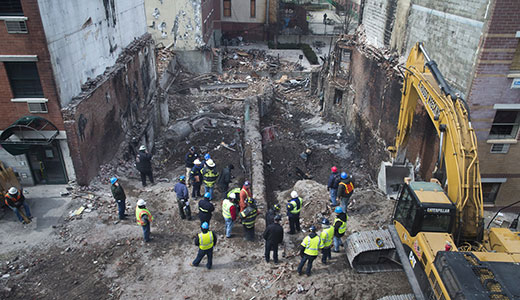
NEW YORK – On Mar. 12, the East Harlem area of Manhattan was rocked by an explosion caused by a gas leak, collapsing two buildings and leaving eight dead. It’s no coincidence that the buildings were served by a 127 year-old gas main, and those in the labor movement are feeling the unfortunate burden of vindication. They have long warned about the outdated gas pipes that wend their way beneath the streets of major cities, an example of the crippled and outdated infrastructure that is becoming a growing problem throughout the country.
According to a statement by the United Steelworkers, the problem of archaic, leaking pipes is a multi-faceted one: “A congressional report showed that in 2011, gas distribution companies leaked enough cubic feet of natural gas into the atmosphere to supply the state of Maine for almost a year. Companies have little incentive to fix the pipes given that they can pass on the cost of the leaked gas to consumers. From 2000-2011, that cost was at least $20 billion. The gas was never used or accounted for.”
Advocates of repair note that new pipelines installed would be far superior to those already servicing cities – most of which are made of cast-iron and date back to a time before the widespread use of cars and lightbulbs. Brigham McCown, consultant and former administrator of the U.S. Pipeline and Hazardous Materials Safety Administration, explained, “People used what they had at the time. By and large in most American cities, that’s a cast iron-type product. It becomes brittle, it becomes harder, and it’s more difficult to get a seal,” which helps contribute to gas leakage.
Consider the fact that Con Edison, the giant utility company that oversees the gas mains in most of New York City, has 60 percent of its pipelines made of cast iron or unprotected steel, with a large portion of those dating back more than half a century. The company has also experienced a high leakage rate, with 83 gas leaks for every 100 miles of main in 2012. Con Edison claims it plans to continually upgrade its gas mains to those made of modern material, planning to replace 65 miles of main per year, at an annual cost of $110 million. But at that pace, it would still take the utility more than 35 years to replace all the cast iron gas mains in New York City, according to federal data. It’s anyone’s guess how many more explosions like the one in East Harlem could occur during that time.
And New York isn’t alone in its problems. Carl Wood, national director of regulatory affairs with the Utility Workers Union of America, and former California public utilities commissioner, spoke with the People’s World on the issue. He remarked, “There have been other high profile gas incidents around the country, like the gas pipeline explosion in San Bruno, California, and the one in Allentown, Pennsylvania.” And this is due to more than just ancient infrastructure, he added. “Dealing with this requires renewing and maintaining a skilled work force. But the big barrier to that is this industry culture that has devalued safety, even for workers.” Gas mains aren’t getting properly fixed, he said, in part because “that costs money and requires staff. Companies are reluctant to spend money on that.
“And there’s another dimension to this: When pipelines leak, methane is released. That’s an extremely potent greenhouse gas that contributes to climate change.”
According to the USW’s statement, methane is “at least 21 times more potent than carbon dioxide.” This makes it an environmental matter as well as a safety and labor issue.
“This is an issue that just cries out for major investment in renewing the infrastructure; you could rebuild it by starting a major jobs program,” said Wood. “And most of those would be good union jobs! But right now, the problem is this all comes down to money. Most of the gas lines in the U.S. are owned and controlled by privately owned gas utilities. Very few are publically owned. To start generating jobs, we need to create special federal and state programs to upgrade and repair gas systems throughout the country.”
The USW concluded, “Fixing our natural gas pipeline can be a powerful jobs program through installing, operating, maintaining, and fabricating pipelines. Steelworkers do much of this work already. These jobs can be supported and more can be created.”
Photo: Workers stand beside the recently cleared basement of buildings leveled by an explosion on Mar. 12. AP










